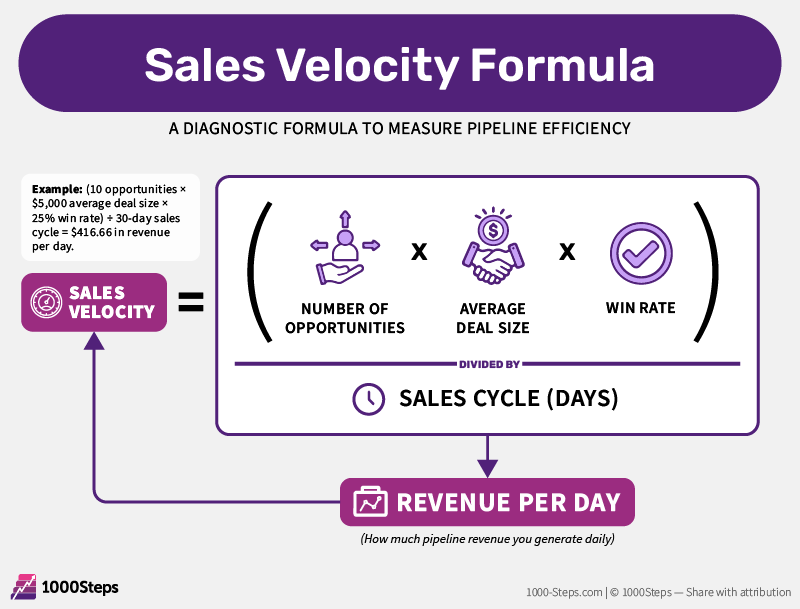A misunderstood formula that reveals your pipeline’s real momentum.
Sales velocity is one of the simplest and most powerful metrics in B2B sales and most teams either don’t track it, or misinterpret what it really tells them.
At its core, sales velocity shows how fast your revenue moves through the pipeline. It combines four metrics into one formula that lets you spot bottlenecks, prioritise improvements, and bring much-needed clarity to sales performance.
Let’s break it down.
The Sales Velocity Formula
Sales Velocity = (Number of Opportunities × Average Deal Size × Win Rate) ÷ Sales Cycle Length
This formula gives you your revenue generated per day, not hypothetically, but based on your actual deal flow.

Here’s what each variable means:
- Number of Opportunities – how many active deals are in your pipeline
- Average Deal Size – typical contract value or revenue per deal
- Win Rate – percentage of opportunities that convert to closed-won
- Sales Cycle Length – average number of days from first contact to closed deal
Example:
If you have:
- 20 opportunities
- £5,000 average deal size
- 25% win rate
- 30-day sales cycle
Then your sales velocity is:
(20 × 5000 × 0.25) ÷ 30 = £833/day
That’s how much revenue your pipeline is producing daily, not based on guesswork, but on current numbers.
Understanding sales velocity starts with the fundamentals. Browse our full B2B Sales Glossary.
Why Sales Velocity Matters in B2B
Sales velocity is like a pulse check on your sales engine. It helps you see:
- How efficiently your team converts leads into revenue
- Whether your pipeline is bloated, sluggish, or ready to scale
- Which lever (deal size, volume, win rate, speed) will actually move the needle
It also forces alignment between marketing, sales, and RevOps. You can’t improve sales velocity without a shared view of pipeline stages and lead quality.
How to Improve Sales Velocity
This is where the formula becomes useful. Each variable gives you a different angle of attack:
1. Improve Qualification
Poor-fit leads waste time. Tighten your ICP and improve lead generation to focus on higher-converting segments.
2. Shorten the Sales Cycle
Speed up deal flow by clarifying handoffs, removing bottlenecks, and standardising your sales process.
3. Increase Win Rate
Often comes down to better discovery, stakeholder alignment, and objection handling. If you’re unclear on your deal stages, you’re not tracking velocity, you’re guessing.
4. Increase Deal Size
Through value-based selling, better scoping, or by adding services and options that make the proposal more impactful.
Tools to Track Sales Velocity
Most CRMs can calculate this with the right fields in place — but few teams actually set it up correctly. At 1000Steps, we’ve helped clients build dashboards that track it in real time.
No CRM yet? Start with a spreadsheet. Keep it simple, but consistent.
✅ Pro Tip: Track sales velocity monthly to spot trends. Sudden dips often reveal hidden issues in qualification, process, or pricing.
Want to Speed Up Sales Velocity?
We help B2B teams build structured systems to move deals faster — without losing control of quality, relationship, or margins.
FAQ About Sales Velocity
What is sales velocity in simple terms?
Sales velocity is how fast your team turns opportunities into revenue. It combines four factors — volume, size, win rate, and speed — into one metric.
Is higher sales velocity always better?
Not necessarily. You can have high velocity but poor margins or low-quality deals. Sustainable growth means balancing speed with structure.
What’s a good sales velocity benchmark?
It varies by industry. Don’t chase someone else’s number — focus on improving your own baseline, month over month.